Managing Energy meters is important for businesses, metering determines the energy flow into your business. Having an incorrect meter can result in lack of energy for the site, which can create electrical failures or create instances where more energy is predicted to be used by the site, therefore increasing standing charges.
Businesses may need to change energy meters for several reasons, and these reasons can vary based on the specific circumstances and requirements of each business. Here are some common reasons why businesses might consider changing their energy meters:
Meter Upgrade or Downgrade:
Businesses may need to upgrade their meters to more advanced models, especially if they are transitioning to more sophisticated energy management systems or require additional features such as interval data for better monitoring (smart metering).
Change in Energy Consumption:
If a business undergoes a significant change in its energy consumption, such as an expansion, downsizing, or a shift in operational processes, it might necessitate a change in the type or capacity of the energy meter.
Technological Advances:
Advancements in metering technology may prompt businesses to replace older meters with newer, more efficient models. For example, the adoption of smart meters can provide businesses with real-time data and more control over their energy usage.
Regulatory Compliance:
Changes in regulatory requirements or standards may necessitate the installation of specific types of meters to ensure compliance. Businesses must adhere to regulatory guidelines regarding metering and reporting.
Renewable Energy Integration:
Businesses incorporating renewable energy sources, such as solar panels or wind turbines, may need to install meters that can accurately measure both the energy generated and consumed. This facilitates proper accounting and, in some cases, eligibility for incentives.
Energy Efficiency Programs:
Participation in energy efficiency programs or initiatives may require businesses to install meters that support specific data collection and reporting capabilities. This helps in monitoring and validating energy-saving measures.
Billing Accuracy:
Meter accuracy is crucial for fair and accurate billing. If there are concerns about the accuracy of an existing meter or if it is reaching the end of its lifespan, businesses may choose to replace it to ensure precise measurement.
It’s important for businesses to work closely with their utility providers and energy consultants to assess their unique requirements and determine if a meter change is necessary. Additionally, businesses should be aware of any regulatory implications and seek professional advice to ensure a smooth transition and compliance with industry standards.
Changing an energy meter is typically a task performed by qualified professionals, usually carried out and authorized by the utility company that owns/supplies the meter.
It is essential to adhere to safety regulations and follow proper procedures when replacing energy meters. Here are general steps involved in changing an energy meter:
Qualified Professional:
Changing an energy meter should only be carried out by qualified and authorized professionals. These individuals are often employed by the utility company or contracted by them.
Notify Utility Provider:
Utility companies need to be informed in advance about any meter replacement. Customers usually need to contact the utility company to request a meter change or report any issues with the existing meter. It is also important if upgrading for expansion, that the grid maintenance network is contacted, this is to ensure the groundwork is available and in place for the required Energy usage.
Assessment and Planning:
Before the replacement, a thorough assessment of the existing meter and the site is conducted. The professionals will plan the replacement process, considering factors such as the type of meter, site conditions, and any potential disruptions. This can involve groundwork where additional wiring is needed to support an increase in Power.
Isolate Power Supply:
Before starting the replacement, the power supply to the meter is isolated. This is a critical safety step to prevent electric shock or accidents during the replacement process.
Remove Existing Meter:
The existing meter is then carefully removed from its housing. This may involve disconnecting wires and ensuring that the old meter is safely detached from the electrical system.
Install New Meter:
The new meter is then installed in place of the old one. The installation process includes reconnecting wires and ensuring that the new meter is securely fitted into the meter housing.
Verification and Testing:
After the installation, the new meter is verified and tested to ensure that it is functioning correctly. This step is crucial to guarantee accurate measurement and prevent any issues with the meter’s performance.
Reconnect Power Supply:
Once the new meter has been verified and tested successfully, the power supply is reconnected. This restores electricity service to the customer.
Documentation:
Documentation of the meter replacement is important for record-keeping purposes. The details of the replacement, including the new meter’s serial number, are often recorded by the utility company.
Customer Notification:
In some cases, customers may be notified in advance of the meter replacement, and they may be informed about any necessary actions on their part, such as ensuring access to the meter location.
It’s important to note that unauthorized tampering with energy meters is illegal and can result in serious consequences. If you have concerns about your energy meter or need a replacement, always contact your utility company, and follow their procedures.
We must emphasize that attempting to downgrade or tamper with energy meters without proper authorization is illegal and against regulatory policies.
Energy meters, especially half-hourly meters, are critical components of the electricity infrastructure, and their accuracy is crucial for fair billing, grid management, and overall system reliability.
If there is a need for a change in meter type, such as downgrading from a half-hourly meter, the process should be handled by qualified and authorized personnel, typically those associated with the utility company.


Recent Comments